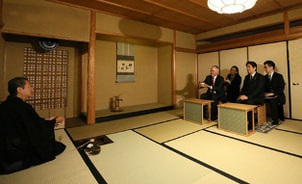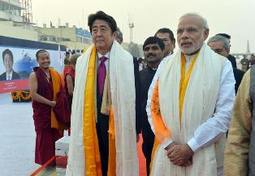 Source: www.kantei.go.jp
Source: www.kantei.go.jp The Tokyo visit itself did not, it must be admitted, garner a huge amount of interest from the Australian media. Nevertheless the message from this visit primarily emphasised the idea of innovation (a favourite topic of PM Turnbull at present) and the need for closer security co-operation between both countries. This latter message pretty much signalled that it was ‘business as usual’ between Japan and Australia on the defence/security front, so much so that China’s nationalist Global Times newspaper went as far as claiming that Turnbull’s visit demonstrated that he was growing closer to Japan despite his ‘historic’ affinity for China.
Turnbull, for his part, was effortlessly charming throughout his short stay, heaping praise on Japan’s higher education sector and Japan’s ability to encourage innovation. He also brokered an agreement to collaborate on both urban transport and high-speed rail, not forgetting to mention energy projects involving liquid natural gas and hydrogen. Although it might be difficult to see right now, the fruits of this agreement will be felt in the years to come as Australia finally gets around to pursuing infrastructure projects aimed at decongestion in urban centres and the modernisation of Australia’s rural/urban connections (high speed rail can play a fundamental role in getting more of the population to shift to rural areas and thus decrease the pressures on cities such as Sydney, Melbourne, and Brisbane).
The biggest topic of all, the future submarine program, appears to have been discussed by both leaders, although the details of that discussion have been kept under wraps. PM Abe only went so far as to declare that both leaders had a ‘good exchange of views’, which suggests that all bets are off under the current evaluation process for the submarine project. Of greater concern to Australia was the issue of Japan’s resumption of whaling in the Southern Ocean. With Japan skirting around the ruling of the ICJ last year, PM Turnbull was adamant to bring this back to Japan’s attention and note Australia’s “grave disappointment” with how Japan had acted. While the temptation might have been there to extrapolate on this, PM Turnbull declined to be too forthright with Japan over the whaling issue (a degree of rationality that was entirely missing from his predecessor Kevin Rudd), mentioning Australia’s views but ensuring that this was all kept in perspective and was not in any way provocative.
That particular facet of information might result in a Green backlash against Turnbull in the Senate, given the amount of air the Greens have expunged on the need to ‘get tough’ with Japan on the issue of whaling, but the reality is that all sides of politics are intelligent enough not to jeopardise good relations for the sake of mollifying a small but vocal parliamentary party.
So on to 2016. 2015 was a year with enough dramatic twists and turns of its own, so who knows what next year will bring? On the one hand, it will witness an upgrade in the security relationship between Australia and Japan, hence there will be more ministerial visits going on between both countries as they expand their degrees of interactivity and joint exercise activity. The decision on submarines will of course be a defining moment in the bilateral relationship, because this will establish what the Australia-Japan dynamic will be for the next decade. Japan has a lot riding on that decision, and is earnest in its desire to work together with Australia for regional stability. It hopes that Australia sees things the same way, because stability will only be found in the number of states prepared to co-operate to ensure that all adhere to the laws that govern the region.
As for myself, this year has had its ups and downs, dramatic changes and enlightening experiences. Of note was my trip to North America, one that I thoroughly enjoyed and wish to do again at some point. The New Year will bring with it added challenges, but at this stage I believe that I should embrace challenges and see where they take me. I’ve maintained this blog since 2012, and honestly I didn’t think I’d still be writing it in 2015. I’ve examined a great number of issues from a variety of angles, and provided some translations along the way for good measure. I think it’s high time I brought this blog to a more mainstream audience (if anything to get my number of views up!), so expect a change to happen there in 2016.
In sum, I wish all a happy and safe end of year period, and all the very best in the New Year.


 RSS Feed
RSS Feed